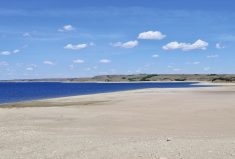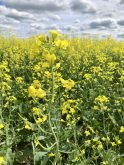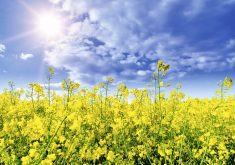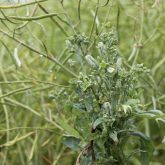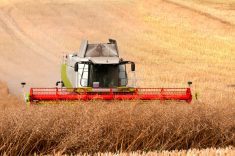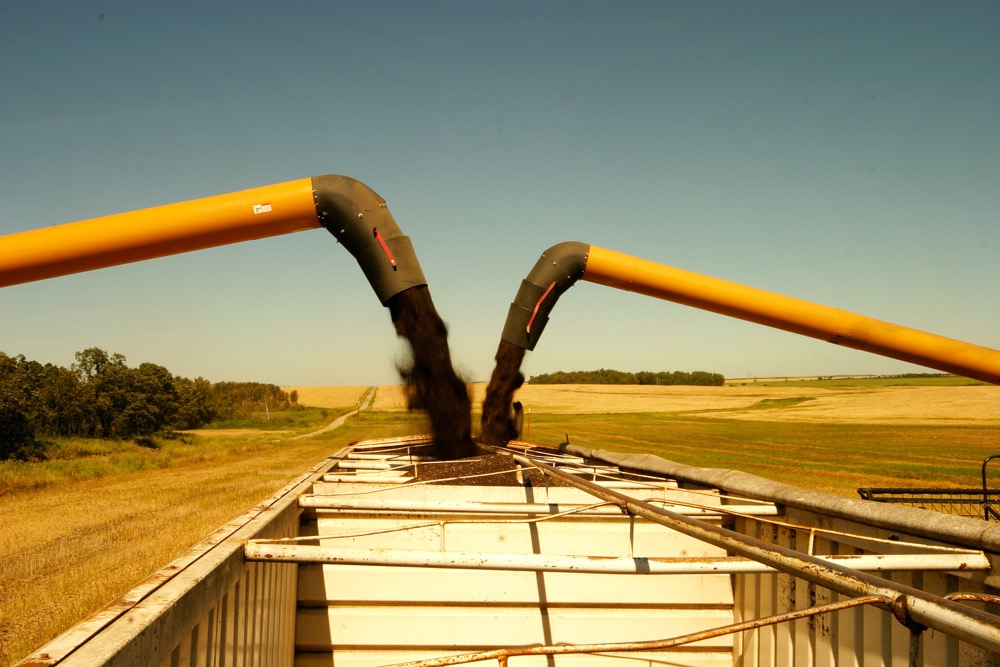Blackleg has a way of sneaking up on you. A farm can go for years without any noticeable problems. But without the grower knowing, blackleg races within a field can shift — often in response to seeding the same genetic resistance source over and over — and infection starts to show up where it hadn’t before. Severity starts to creep up, with a rating of 0, then 1, then 2. Then bang!
The next time canola goes on that field, plants start dying off in big numbers in August and the grower wonders what’s the matter. By then, yield loss can be significant.
Read Also

Could crop sharing be a viable option for your farm?
Crop sharing could be a good option for young and beginning farmers.
Fortunately, this is still a fairly rare occurrence in the current blackleg era on the Canadian Prairies. However, incidence is increasing (see chart at bottom). The purpose of this article is to encourage growers to check canola crops this fall — ideally a week or two before cutting or shortly after — to see if blackleg is showing up.
If it isn’t, that’s good. You can use this year as the year-one benchmark in your new blackleg scouting program.
“The ultimate goal is to catch blackleg before it gets serious enough to cause yield loss, and then take preventive measures to keep levels low, or make them low again,” says Clint Jurke, agronomy specialist for the Canola Council of Canada. “It can be done.”
- From the Manitoba Co-operator: Wanted for science: Southern Alberta canola fields
How to scout
Review what you’re looking for. Many young growers may not be familiar with blackleg because it was so long ago that it was a major issue. Throughout the season, blackleg symptoms can include leaf, pod and stem lesions. Leaf spots are dirty white, round to irregularly shaped, and usually dotted with numerous small, black pycnidia. Pycnidia appear as tiny round specks that may be seen more easily with the aid of a hand lens. These specks are a distinguishing feature of blackleg.

Basal stem lesions — “cankers” — are associated with serious yield loss. Stem lesions may be up to several inches in length, and are usually white or grey with a dark border. Numerous pycnidia form in the centre of the lesion. Basal stem lesions may also appear as a general blackening at the base, often producing a gnarled, woody appearance.
“Basal stem infections are what you’re looking for with the pre-harvest scout — which is the easiest time to accurately identify blackleg,” Jurke says.
Step two in blackleg scouting is to get a good set of garden clippers. Then in the week or two before harvest, select 20 random plants from a few locations in the field. Pull up each plant and clip the stem just below ground level. Look for black discolouration of the cross-section. A rating of 0 means no blackleg stem discolouration. A rating of 5 means the stem is completely discoloured and blackleg has killed the plant. A wedge of black that covers 26 to 50 per cent of the cross-section is considered a 2.
“Varieties with a resistance rating for blackleg should have very low infection levels. If R-rated varieties are showing damage levels higher than 1 on average across a field, that means the pathogen population might have shifted or increased substantially and the variety is no longer resistant to the races in that field,” Jurke says. “It is time to take action to prevent major yield losses the next time canola goes on that field.”
How to manage blackleg
Genetic resistance is the simplest and, for most fields, the most effective blackleg management tool. Blackleg has not been an issue at all for most growers since the late 1990s when resistance was first introduced in a big way.
However, disease surveys show an increase in blackleg incidence across the Prairies over the past five years or so, especially in Manitoba and Alberta. “Tighter canola rotations are likely a factor,” Jurke says. “We are relying heavily on resistance alone to manage the disease, and very few are actually scouting for it.”
A key component of integrated pest management (IPM) of blackleg is to add diversity to the operation by rotating crops, hybrids and fungicides. “The most effective management is to extend the canola rotation on a high-risk field to at least a two-year break,” Jurke says. “Rotating hybrids and fungicides could also help — although research is ongoing to determine the best ways to apply these steps.”
Gary Peng, research scientist at Agriculture and Agri-Food Canada (AAFC) in Saskatoon, worked with researchers from University of Manitoba and from Alberta Innovates on a fungicide assessment over the past few years. “The research does not show an economic benefit to fungicides for blackleg control — except when susceptible crops are grown under high blackleg pressure,” Peng says.
Other AAFC research in Saskatchewan in the late 2000s found that burning canola residue and tillage did not reduce incidence rates.
Ongoing science
Researchers with AAFC in Saskatoon and University of Manitoba are working on ways to improve our blackleg monitoring. “We want a system where we can quickly identify which pathogen races are present in a field and across a region, and then identify canola varieties with effective defence mechanisms that line up with that group of races,” says Peng.
“That way, growers can choose hybrids with resistance to the blackleg pathogen races present in their fields or region, and also make more informed decisions when it comes to rotating varieties and preventing virulent races from becoming dominant,” Jurke says.
The project needs growers to participate in collecting samples this fall and for the following three years. If you are interested, please email principal investigator Dilantha Fernando with the University of Manitoba.

Jay Whetter is communications manager with the Canola Council of Canada, and editor of the free Canola Watch agronomy newsletter. Sign up at www.canolawatch.org and follow @CanolaWatch on Twitter. To read a summary of Phase 1 of the blackleg identification study, read the Canola Digest Science Edition 2013. Look for study 3.3.



